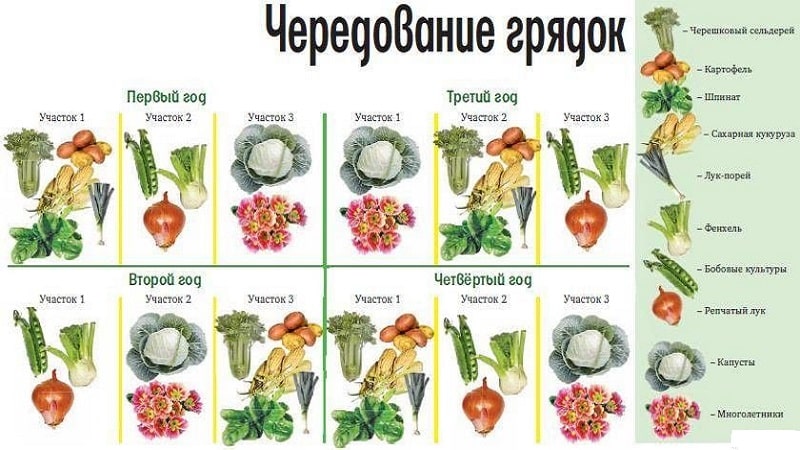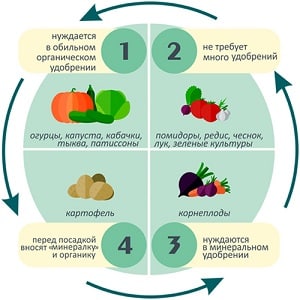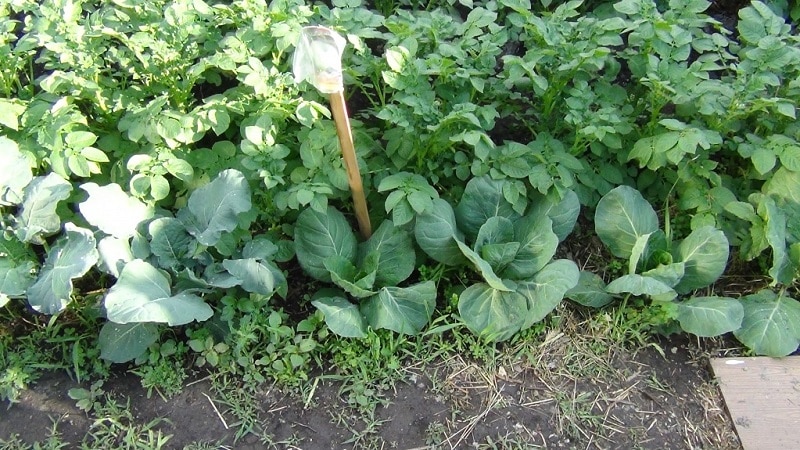After which you can and cannot plant cabbage next year
To get a good cabbage harvest, it is important not only to purchase high-quality seeds or seedlings and follow agricultural practices, but also to have an idea of proper crop rotation. From this article you will learn how to plant cabbage next year.
Then plant cabbage next year
According to the general rules of crop rotation, the best predecessors for cabbage – plants from the legume family and grain crops.
By the way! Cabbage planted in beds after onions and garlic will hurt less.
She's growing well after tomatoes and cucumbers, potatoes and carrots.
There are several principles of crop rotation. One is to consider the rate at which plants extract nutrients from the soil, depleting it. So:
- Cabbage, carrots and beets greatly deplete the soil;
- medium – tomatoes, eggplants, peppers, zucchini, onions, pumpkin, potatoes;
- weak – peas, spinach, cucumbers, radishes, lettuce;
- Other legumes enrich the soil.
In this case, plants alternate from strong to weak, i.e.:
- first they grow cabbage;
- next year - representatives of the second group;
- on the third - weakly depleting the soil;
- on the fourth - legumes;
- the cycle is repeated.

The second principle of crop rotation is based on the belonging of plants to different families.. The alternation occurs as follows:
- Option 1: nightshades (tomatoes, peppers, eggplants) – legumes – cabbage – umbelliferae (carrots, dill, parsley);
- Option 2: pumpkin – legumes – cabbage – goosefoot (beets, spinach);
- Option 3: nightshade – legumes – cabbage – goosefoot.
According to the third principle, plants are conventionally divided into four groups:
- leafy: cabbage, lettuce, spinach, onion;
- fruits: tomatoes, zucchini, cucumbers, eggplants, peppers, pumpkin;
- root vegetables: radishes, turnips, beets, root parsley, carrots, daikon, potatoes;
- legumes: peas, beans, chickpeas, beans.
The rotation of crops occurs as follows:
- 1 year: fruits are placed on 1 bed, root vegetables on 2, legumes on 3, cabbage on 4;
- 2nd year: 1st bed - root vegetables, 2nd - legumes, 3rd - cabbage, 4th - fruit;
- 3rd year: 1st bed - legumes, 2nd - cabbage, 3rd - fruit, 4th - root vegetables;
- 4th year: 1st bed - cabbage, 2nd - fruit, 3rd - root vegetables, 4th - legumes.
The fourth principle of crop rotation is the simplest. This is an alternation of “roots and tops”. One year, plants that form root crops are planted in the garden bed, and the next year, plants that bear fruit on the tops.
By the way! Corn is not taken into account in crop rotation. This is a neutral crop, but wireworms love to live under it. This fact should be taken into account and measures should be taken to destroy it.
The fifth principle takes into account bad and good predecessors. More on this below.
The best predecessors
 As precursors for white and cauliflower legumes, zucchini, and onions are good. Tomatoes and cucumbers are acceptable. But there are nuances regarding different types, as well as ripening periods.
As precursors for white and cauliflower legumes, zucchini, and onions are good. Tomatoes and cucumbers are acceptable. But there are nuances regarding different types, as well as ripening periods.
Thus, early potatoes and carrots can be precursors for white and cauliflower of medium and late varieties, but are not suitable for early varieties.
Kohlrabi grows well after carrots, beets, potatoes and corn.But it is best to plant it in the beds after onions, zucchini and cucumbers, if manure was applied under them. As replantings, this species is placed after early harvested peas, green crops, lettuce and early radishes.
For the Savoy, the best predecessors are considered perennial herbs, potatoes, tomatoes, cucumbers, legumes, onions. The worst are radishes, rutabaga, turnips, watercress, and radishes.
Brussels sprouts of early varieties are grown after onions for turnips, cucumbers and tomatoes. Clover will be an excellent predecessor. Acceptable are potatoes and legumes (both for blades and seeds). Medium and late varieties grow well after beets, carrots and the already mentioned crops.
Suitable predecessors for red cabbage - beets, potatoes, cucumbers, tomatoes, legumes, onions.
Take note:
Unpretentious late-ripening cabbage hybrid Prestige f1
Good and bad neighbors
In addition to alternating crops in crop rotation, their proximity is also taken into account, which affects productivity. This is especially true for small areas.
Good neighbors:
- celery – protects against flea beetles;
- leek - repels the garden cutworm;
- dill - from caterpillars and aphids;
- anise - from cabbage fly;
- borage (borage) – protects against slugs.
They will help in the fight against cabbages:
- mint;
- chamomile;
- hyssop;
- rosemary;
- sage;
- thyme.
The productivity of cabbage increases in proximity to:
- chard;
- beets;
- potatoes;
- spinach;
- beans;
- chicory;
- tomatoes;
- various types of salad;
- cucumbers

Are considered bad and oppressive neighbors:
- grape;
- parsley;
- tansy.
What crops cannot be planted after?
Cabbage cannot be planted in the same place every year.. Ideally, she should return after 3 years. But in the limited space of a summer cottage, this can be difficult to achieve.
Then green manure comes to the rescue:
- winter rye;
- Vika;
- peas;
- lupine;
- mixtures of these plants.
Using them, the crop is returned to the same bed a year later.
Also, the crop cannot be grown after other cruciferous vegetables. - turnips, radishes, lettuce, radishes.
Important! Mustard cannot be planted before cabbage as green manure.
Crop rotation and manure application
It is advisable to apply manure under cabbage, since she needs the maximum amount of nutrients. It will not be added in the next 2 years.
In the second year, tomatoes, carrots, beets, and onions will grow well, and in the third year, strawberries, herbs and peas. You can also apply this order:
- 1 year – manure for cabbage;
- 2nd year – cucumbers;
- 3rd year – tomatoes;
- 4 year – carrots.
Read also:
The best Dutch varieties and hybrids of white cabbage
The best varieties of cabbage for pickling and storing for the winter
Conclusion
Good results when growing cabbage can only be achieved by following the rules of agricultural technology. These include crop rotation and plant compatibility. Choosing the right predecessors will help you get a good harvest of this crop.